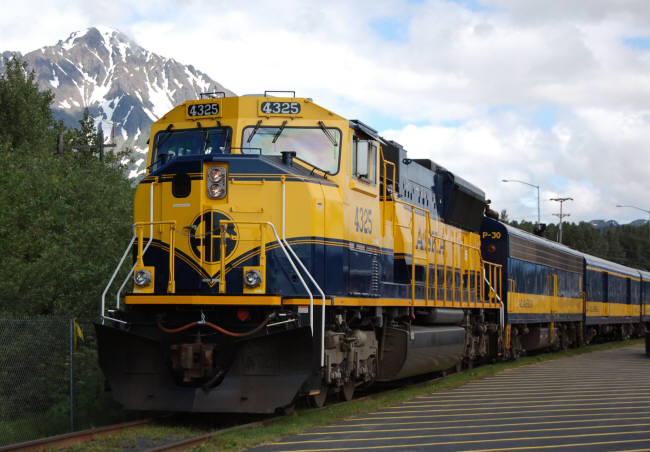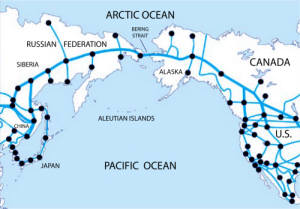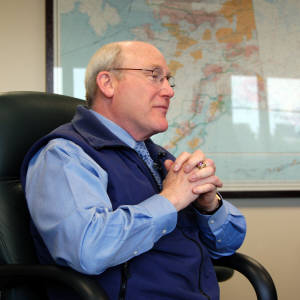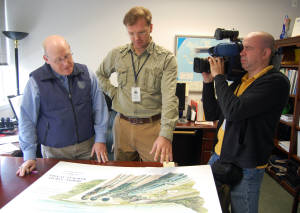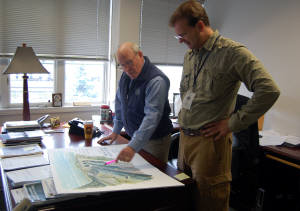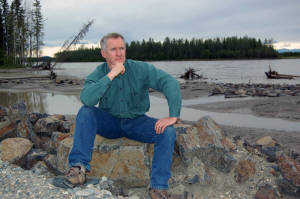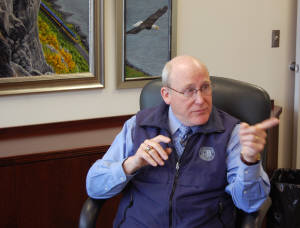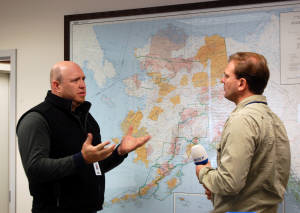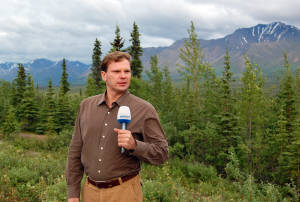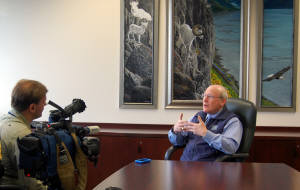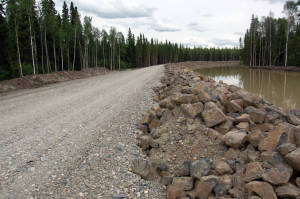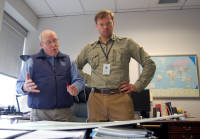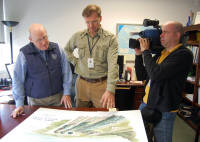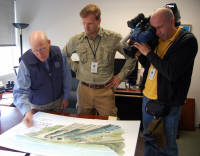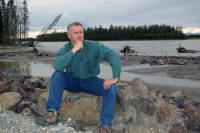"BIG TICKET". Is Alberta to Alaska Railway Port Mac's Sugar Savior? The railway may become a reality in 2022 if Sean McCoshen of A2A Railway has his way. By Dennis Anderson, AP, Jan. 3, 2019.

INTER. Sept. 23, 2012
RiaNovosti, May 13, 2014
InterBering, LLC
BERING STRAIT TUNNEL & RAILROAD
CONSTRUCTION INVESTMENT CORPORATION
English
Connecting people and continents.
April 28, 2012
--------------------------------------
--------------------------------------
--------------------------------------
America - Asia - Europe
International Railroad
--------------------------------------
--------------------------------------
--------------------------------------
--------------------------------------
--------------------------------------
--------------------------------------
By Ed Peters, South China Morning Post, Oct. 4, 2020.
After clicking the arrow, please wait from 20 sec. to a minute for downloading this video (in Russian).

Connecting America and Russia By Railway Tunnel
television channel INTER on September 23, 2012.
Author: Maksym Drabok. Camera: Mykyta Isayko.
Maksym Drabok,
correspondent, Head of U.S. Bureau of Ukrainian TV-Channel Inter, Alaska.
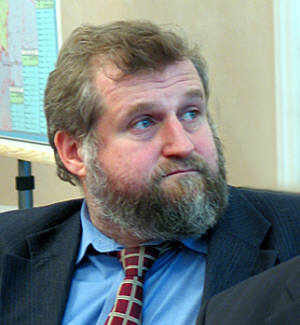
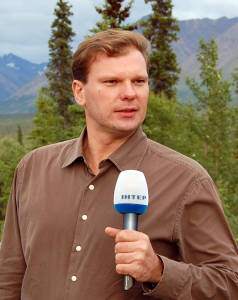
Bruce E. Carr, Director Strategic Planning,
Alaska Railroad Corporation
Bruce E. Carr, Director Strategic Planning,
Alaska Railroad Corporation,
Maksym Drabok, Correspondent, TV-Channel Inter, Cameraman Mykyta Isayko
Bruce E. Carr, Director Strategic Planning,
Alaska Railroad Corporation
Clark C. Hopp, Director Special Projects,
Alaska Railroad Corporation
Victor Razbegin, Vice-President of
International Corporation Intercontinental
Fyodor Soloview, Founder InterBering
Maksym Drabok, Correspondent,
Head of U.S. Bureau of Ukrainian TV-Channel Inter
Original TV broadcasting (in Russian)
[Voice-over] "A rail tunnel running from Russia to Alaska. In the foreseeable future there very well may be a railroad track connecting America directly with Europe and Asia.
Science fiction? No, reality.
The idea itself was born in the 19th century and seriously considered during the reign of Russian Czar Nicholas II.
But work on such a bold project was prevented first by World War I and then by the Russian Revolution and ensuing "Cold War" between the U.S. and USSR.
Now, Alaska has seen tentative steps taken reserving land for a future transcontinental railway. On the opposite side of the Bering Strait the Russians are laying down a connecting railroad to their port of Chukotka. This project, if completed, could be one of the most consequential endeavors in all of human history.
So, when will trains cross directly from Eurasia to America? Reporting from Alaska is our own INTER correspondent Maksym Drabok."
[Maksym Drabok] "The entire globe in a railway network [graphic shows a railway grid covering the earth]. This global web of rails is not a fantasy.
That's how all continents will one day be connected. From Europe and Asia, the United States in the near future will be reached not only by plane but also by train. This is what the Director of Strategic Planning for the Alaska Railroad Corporation, Bruce Carr, is certain of.
So when? I for one am very ready to ride."
[Bruce Carr] "It's probably one of the last great infrastructure projects left in the world, if you stop and think about it. Connecting the North American continent with the European-Far Eastern continent through a tunnel underneath the Bering Strait. It will happen."
[Maksym Drabok] "To do this, what's needed is a tunnel underneath the Bering Strait separating American Alaska and Russian Chukotka.
Once upon a time this place was dry land. Primitive people crossed from Asia to America and settled an uninhabited continent.
Now there is water there. A connecting tunnel under the Bering Strait would be about sixty-four miles long. This is two times the length of the Channel Tunnel. But, thanks to two islands - America's Krusenstern Island (Little Diomede) and Russia's Ratmanova Island (Big Diomede) - the tunnel could be divided into three parts, greatly facilitating the work.
There would be no real technical difficulties, experts say."
[Victor Razbegin, Vice-President of the international corporation Transcontinental, in Moscow] "The depth of the tunnel would be 100 feet. No more. In general, the sea bottom there is flat or gently sloped and very easy to build on.
The soils are also quite stable, and there is no special seismicity. This is not a seismically active zone."
[Maksym Drabok] "Bruce Carr shows a drawing of the tunnel under the Bering Strait. That's how the Americans have imagined it. And it includes an important point. In Russia trains run on electricity. In the United States diesel locomotives are common.
So on each side of the tunnel there would be facilities to provide the transition."
[Bruce Carr] "We would take those locomotives coming from Russia off and put on our American locomotives. The cars stay the same."
[Maksym Drabok] "In addition to the tunnel, over five thousand miles of rails and railway sleepers would have to be placed.
The cost of the project, including the American and Russian sides plus a tunnel under the Bering Strait, would total about $100 billion.
A huge amount. But that is one-tenth the cost of the wars in Iraq and Afghanistan. And it would create a true global land transportation system.
Think of a railway as a rod on which much other development infrastructure can be strung. Cities will begin to develop along with new industry. In Alaska and Siberia there are huge reserves of coal, oil and gold. But few roads.
The economically undeveloped Siberian territory is itself more than one and a half times the size of the entire European Union. The costs of the railway could be repaid in 15-20 years once the new railroad can enable the movement of goods. China too will help with this.
One of the promoters of this project, Alaskan Fyodor Soloview, explains."
[Fyodor Soloview, Founder of InterBering, in Anchorage] "Alaskan coal from Point Lay could be moved more economically by rail under the Bering Strait and through Russia.
This would pay enormous dividends while also producing transportation revenues. China, too, would likely make use of the new railway to import more coal from Alaska."
[Maksym Drabok] "In the opposite direction Chinese goods could go to Alaska. Now everything in Alaska is much more expensive than in the other U.S. states because products are imported by aircraft and boat.
For example, in Alaska there are no buildings made out of brick. It is unprofitable to deliver it here. The railroad will change that situation.
The overall flow of freight traffic in the world will also adjust, experts say. Now the major flow of goods between Asia and America is by sea which takes a month. By land it will be five times faster."
[Victor Razbegin] "Construction, including the design and all the necessary research and so on, will take no more than eight years. Optimistic Japanese say they could complete the project in five. And the Chinese? 'Well, we could do it even faster,' they say.
But really, eight years is a timeframe upon which all seem to agree quite confidently."
[Maksym Drabok] "In Alaska, the railway network is gradually developing. This segment is the construction of 80 miles from the town of North Pole, where American children write letters to Santa Claus, to the town of Delta Junction.
Builders complain that it's very long and difficult to negotiate the route with environmentalists. They must double-check how the project will affect the course of every stream and animal track."
[Clark Hopp, Director, Special Projects, Alaska Railroad Corporation] "We started the environmental process in 2005 and we did not receive approval to begin construction until 2011.
So it took a six-year process for us to do different types of environmental studies which looked at possible effects on humankind, possible effects on environment. We also had talks with the native communities. Our first and best practice is to try to avoid impact. If we had impact on a stream than we needed to figure out how to either move that stream or protect it from additional impacts."
[Maksym Drabok] "In Russia, these issues are resolved quickly. There is the problem of finances, but there is an understanding of the need to develop the north.
The plan of development for the Russian railway network includes the possibility of connecting to Alaska. But preventing this have been the various conflicts between Moscow and Washington, and now the present world financial turmoil."
[Bruce Carr] "I think it's a mind-boggling project for the American side and the Federal government that would have to help support it. Our Federal government is focused on the economy and our economic issues right now. But at some point in time the value of this project will be recognized by everybody. And it will happen; it will be a reality."
[Maksym Drabok] "Maybe my grandchildren will be able to take the train to Moscow?"
[Bruce Carr] "I would say not your grandchildren. I can say maybe your kids could do that. So, that will be fabulous."
[Maksym Drabok] "Everyone understands the economic benefits of the project. But they are in no hurry to start building. The main reason is politics. The parties cannot agree, and seem afraid to help each other develop resource-rich regions. It's like, 'We can open the Far East for the Russians but then they might close the borders.'
Stereotypes of the Cold War are still relevant. Perhaps rails and sleepers could finally reconcile and make peace between Moscow and Washington."
- Maksym Drabok and Mykyta Isayko for the program "Details of the Week," on television channel INTER.
This levee completed in Salcha, Alaska in 2012 by Kiewit Infrastructure Group, West Co, protects residential properties from flood and provide dry and safe access to the construction site to build a railroad bridge over the Tanana River, a part of the Northern Rail Extension Project.





